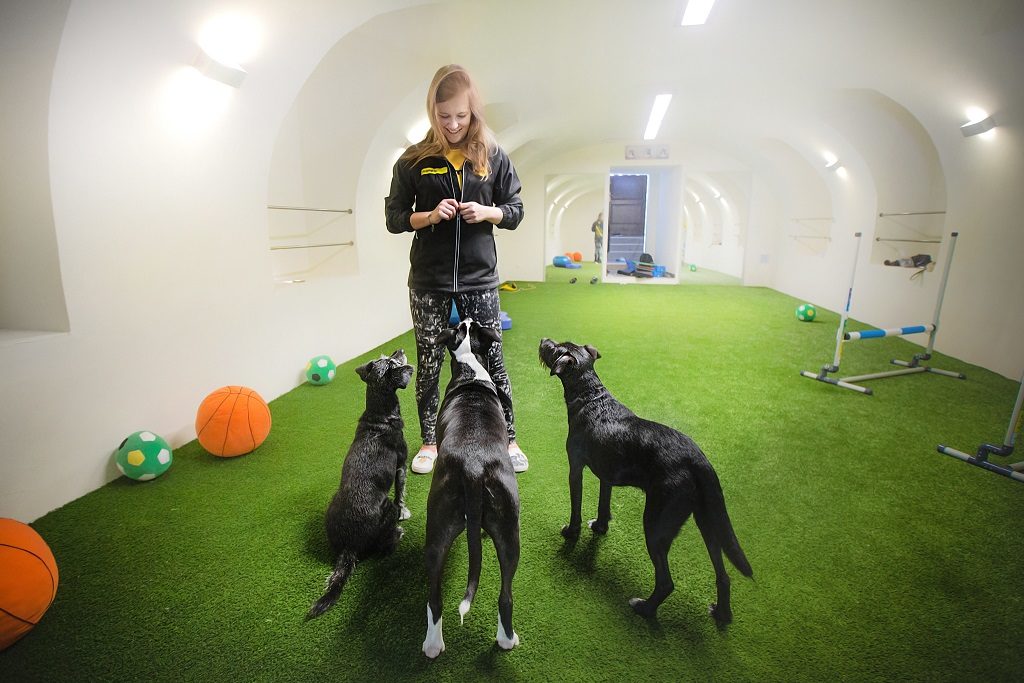
Antecedent arrangements can help you achieve success! But I think that we don’t spend too much time on considering the use of them in our training. They can literally make your life so much easier. Before I go into more details let me just tell you a story.
At some point Gunia (one of my dogs with history of aggressive behaviors, more to read here) started to exhibit problematic behavior after getting out of the car. She became very alerted, unresponsive to our cues, very responsive to environmental cues, her first reaction to opening crate door was lunging and pooling on leash to move forward. Of course I could start with a behavior change program, focusing on shaping new behaviors, replacing the ones that she already presented after she got out of the car. Instead I first focused on changing the environment that she enters,after she is released from the car crate. Every single time I have placed a snuffle mat the moment I have opened the crate doors. 100% of time, no matter what she was doing, lunging or sitting quietly, or sleeping. When we got back home where she didn’t present those behaviors she also got her mat. The mat was always present when the crate doors were opened. If I drove for a walk and forgot the mat I would have returned home and got the mat. Gunia’s behavior changed drastically. She started to expect a snuffle mat when the crate doors opened. We successfully broke the contingency between behavior of running out of crate and reinforcement. We also created new contingency, the one we wanted. Also we made engagement in problem behavior difficult – mat in front was easier to engaged with.
What exactly happened that changed her behavior? Even though I did nothing to directly teach her different response when we opened crate?
What are antecedent arrangement, operations?
They are antecedent manipulations of environmental events prior to the occurrence of the behavior. Could be either problem behavior or the occurrence of the behavior we target to increase, to replace the problem behavior.
What are the mechanisms of the antecedent arrangements?
- Breaking the contingency! They break or weaken the contingency between the problem behavior and the maintaining consequence. From my example with Gunia and the snuffle mat. Lunging stopped producing maintaining consequence, because of the occurrence of the mat.
- Make the unwanted behavior more difficult or even impossible to engage in. This is one of my favorite. If you don’t want some behavior to happen, the easiest way is to make it more challenging to engage into and simultaneously make the one you want the easiest option for the animal.
- They change the value and effectiveness of the consequence and can evoke or abate the behavior that precedes those consequences.
- They can also change the discriminative control over behavior – change cues evoking the behavior.
Although antecedent arrangements exclude interventions in which there is an explicit contingency between behavior and a consequence, there can be time-contingently delivery of preferred stimulus following the occurrence of some behaviors. BUT our delivery is not contingent on any behavior. No matter what your dog, horse or cat does, you deliver preferred stimulus.

There are many antecedent interventions that are listed in the literature. I will focus on just few that I find very important in our work with animals.
Enriched environment – often problem behaviors are maintained by lack of access to particular reinforcement. Providing noncontingent access to social interaction, food, toys can function as an abolishing operation. Enriched environment can also provide an opportunity for us to reinforce appropriate behavior. EE is more effective when we use high preferred stimuli and if those stimuli are varied. That’s why I am a big fun of leaving my dogs at home with multiple toys and snuffle mat activities.
Antecedent Exercises – involving our animal in the systematic exercise program. It cannot be done contingent on problematic behavior. It is not a punishment. The problem with this one is that it is not verified empirically, but it is likely to have a motivating operation effect.
Relaxation exercises – behavioral relaxation involving some respondent processes such as counter conditioning. Focused on muscle relaxation. For people it can be yoga class, for dogs, TTouch
Time-based schedules – that’s the one I think people are afraid of. That’s what I did with Gunia. How can you provide preferred stimulus without a response requirement? They have contingency breaking effect. If you receive something no matter what you do, why would you engage in a problem behavior (often they are effortful and physically exhausting), the best option is of course if we deliver stimulus that is contingent on the problem behavior. That way we use AO effect for this item. If you have plenty of food why would you try to get more. If your dog has plenty of access to you (social contact) he will not seek it in other situations (problematic for you).
What we need to know about the effect of antecedent arrangements?
- Operant antecedents do not function independently of consequences. It is the consequence that drives the behavior.
- Consequences will affect long-term effect of the behavior change plan.
- Often antecedents manipulations will only have transitory or even momentary effect.
- That’s why antecedent arrangements should only be a part of the plan to use reinforcement. With my example with Gunia. I have also introduced other procedures after the effect of antecedent arrangements. BUT I would not have been able to do so without antecedent manipulations. Or at least the process would have been much more challenging and time consuming.
Okay so we already know antecedent arrangement is something to look into when we talk about problem behaviors. But does it relate to sports training? Or any dog training at all?
We will talk about this topic in the next week article Antecedent Arrangements part 2! We will also discuss setting events and ecological variables and High-P sequence!
